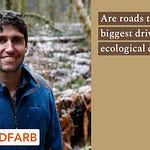Re-posted from here to match the podcast layout.

Steve Brusatte is a paleontologist who studies the evolution of dinosaurs and mammals.1
In his latest book, The Rise and Reign of the Mammals, most chapters begin with a semi-fictional story of a fossil critter in an archaic landscape. It’s a chronicle of competition, skeletal changes, disaster species, and new life.
We spoke in January 2024.
Ryan: If you were going to be the guy to show fossils to visiting aliens, which ones would you show them first?
Steve: If aliens came down, they might be more weird and wacky than any fossil that we know of. There might be aliens out there that look like dinosaurs, and if you showed them the t-rex they might be like, “Oh yeah!”.
I would go for something like a t-rex or a brontosaurus. Those are the ones that, for me, evoke the most awe and majesty and get my mind racing. They are so unusual and weird compared to anything alive today. They’re kind of the most alien dinosaurs. I would show those to anybody.
Humans might have the only minds in the universe that can understand fossils. It’s a knowledge that connects us to every other living thing, and none of them can grasp the idea.
We’ve only recently been able to put accurate dates on rocks.
African slaves were the first people to find and accurately identify North American fossils along the Stono River in South Carolina in 1725. Specimens of mammoth teeth, which resembled elephants they’d seen in Africa, ended up in collections like Thomas Jefferson’s at Monticello.2
Early Greek philosophers like Xenophanes (570-480 BC) and Herodotus (484-425 BC) wrote about fossil seashells, mentioning the ocean once covered areas that were now dry land.3
So there was some early intuition about fossils being ancient.
Georges Cuvier (1769-1832) demonstrated extinction is real based on mammal fossils. His theory was that extinctions were the consequence of great catastrophes.4
William Smith, born the same year as Cuvier, was a canal surveyor who made the first geological map of England. He recognized the ordered timeline in which rocks formed, and established deep geological time scales, far older than a few thousand years.5
Ryan: What goes through your mind when you’re looking for fossils? Are there any digging animals you feel a kinship with?
Steve: I try to be present enough to not be hitting my hand inadvertently with a hammer.
First you find your spot. When we get to a new area, or an area we’ve been to before, we’re going to start off by prospecting, walking around, covering a lot of distance, getting a broad survey of the rocks. Is there anything interesting sticking out? If we see something of a different color, texture, or a biological shape, then we’ll stop. That’s when we would get our tools out and start digging.
You try to establish a perimeter right away. What do I have? Can I tell is this a bone? How big, what bone? If it’s a thigh bone vs. a shoulder blade, they’re going to have different shapes and go into the rock in a different way.
You’re trying to picture what is inside of the rock, which is impossible, but your trying to use the knowledge you have to act like an x-ray machine and predict. In that way I guess we’re kind of like some animals that burrow and move underground through echolocation with kind of a sixth sense. Maybe we’re a bit like that.
Although we don’t really have a formal sixth sense, the more experienced you are with fossils the more you have an instinct. It would be that kind of animal.
We’re not going to be like a dog that’s frantically ripping apart at the rock because it smells something interesting down there, so we try to be a bit more precise.
Naked mole-rats from the Horn of Africa and their ilk, like the golden moles of southern Africa, and blind mole-rats found in Eurasia, rely on chirps and clicks to navigate, find food, and identify each other through soil. Undoubtedly these unique burrowers have bumped into fossils in their subterranean habitats that paleontologists would love to get their hands on.
Marsupial moles in Australia, rarely seen, were originally thought to be in the same family as African and Eurasian moles, but closer study revealed that they are a case of convergent evolution, separated from other moles (and all placental mammals) by at least 125 million years.6
Primates originated in Africa, and something spectacular happened to bring them to South America.
Ryan: You mentioned that the oceanic dispersal of primates to South America was an unlikely event. What would those rafts have been like, and do you think that was a random accident or was hopping on rafts some kind of regular strategy?
Steve: We know a couple things. First, there are primates that live in South America. They had to get there somehow, and their DNA shows quite clearly that they evolved from African ancestors.
They evolved at a time when there was no land connection. South America was an island continent, until just 2.5 million years ago. They definitely came over before then. They had to somehow reach this giant island from Africa. And really, the only way that makes any sense, is that they somehow sailed across the ocean.
Africa was also isolated for a lot of that time. You have two island continents.
Could they have maybe gone overland somehow? Hitched a ride through Europe to Asia and North America and down? That’s an even more unlikely thing because we have no fossils of those ancestors, and that would require several jumps across water. It’s really quite clear that something unusual happened when these animals went from Africa to South America.
The second thing that we can observe is this happens with modern animals sometimes. Not such extreme crossings of large bodies of water, but we do often see, after storms, that these rafts of vegetation, floating logs, and downed trees, these things have animals on them sometimes, and they can drift far out into the water.
When we say the word raft, I think what comes to mind is like a shipwreck. Some person clings on to a bit of wood from the ship. And they’re on this tiny little thing in the middle of the ocean, the middle of nowhere. A little speck in a raging, angry sea.
But rafts that have been observed after storms can be huge, bigger than a football field, much bigger sometimes. Huge amounts of trees and stuff washed up in the storm that are really big. They could provide habitat. There would have been food on those rafts: fruits, flowers, and bugs. It would have been like a floating island. So that’s probably what they were.
I imagine it was by accident. These things would have been torn off the coast and went across the ocean. But you never know, maybe it was a survival strategy, in cases of an extreme storm, to hop on these things. It’s hard to know for sure, but all we really know, is improbable things did happen.
Being on top of the ocean, moved by unpredictable wind and current, is far from a safe bet. Perhaps it was an accident. But rafting does open up hunting opportunities.
Polar bears and brown bears diverged from each other about 425 thousand years ago, as Polar bears adapted to spend up to 6 months a year on sea ice.7 They evolved to their aquatic environment relatively quickly, with webbed feet and incredible insulation.
Sea otters and beavers also call into mind an intelligent, semi-aquatic lifestyle, and an ability to shelter among tangled logs and debris.
The oceanic dispersal of primates to South America by rafts might be one of the most unlikely coincidences of natural history.
Ryan: If you ran a simulation of Earth, and assume multicellular life emerges, how likely do you think vertebrates and large mammals are to reappear?
Steve: Steven J. Gould, in his books, talked about this. What would happen if we ran the tape back, rewound to 4.5 billion years ago and let the world unfold again and again. His argument was that things would be very different, in almost unpredictable ways.
The little butterfly effects. Every tiny little thing would have led to ramifications over billions of years.
Others have argued that evolution has constraints, that we often see the same features evolve over and over again. If you’re going to adapt to a certain environment, there’s ways that work and ways that don’t.
If you’re going to eat meat, you’re going to want sharp teeth that look like little steak knives. If you’re going to run fast, you’re going to want long, skinny legs.
In that mindset if you reran the tape of life, you would get something quite similar. The same law of gravity and laws of matter apply. Evolution only has so many options.
I don’t really have a firm opinion. Generally, I feel that a lot of evolution is pretty contingent, just like our own lives. Little things in our own lives happen and build up over time.
If we reran the tape of our own lives, we would probably have similar outcomes some times, but quite different outcomes a lot of the other times. I would think evolution to be something like that.
Certainly, it would never come out exactly the same.
Ryan: Warm blood is expensive, but it unlocks things like nocturnal activity, brain power, and stamina. How do we know from fossils when animals became warm-blooded?
Steve: It’s a real challenge and a lot of people have been debating this for over fifty years. When it comes down to it, it’s really hard to know if an extinct species was fully warm blooded the way we are. Meaning that they had high body temperatures that were constant, regardless of the season or time of day, and that they maintained those high constant temperatures through an internal furnace, an internal metabolic mechanism.
After all, something could have a high constant temperature because it lives in Hawaii and is out in the sun all day.
Internal control, high body temperature, and constant body temperature defines the type of warm blooded that we are.
What we can tell from fossils often is something about growth. They are growth rings in bone, like tree trunks, that tell us how quickly things grew. We can calculate growth rates. We can tell generally if animals were faster or slower growing. That has something to do with metabolism.
We can tell from the skeleton of animals, how active, energetic, dynamic they might have been. But as far as figuring out whether something was full-on warm-blooded, really you need to stick a thermometer into something and see how its body temperature changes as seasons change, day turns to night, and so on. You can’t do that.
People have devised different ways of using chemical techniques, measuring isotopes and elements in bones and teeth of fossil species, things we know in modern day animals correspond to different body temperatures. Different types of minerals form at different temperatures. People have looked at this evidence and its promising, but it’s far from slam dunk. There’s a lot of debate about that still.
Warm blood enables faster bone growth. The size of pores and cellular structures in bone (fibrolamellar) reveal something about the size of blood cells, high oxygen content, and warm-bloodedness.
Once we had internally generated heat, it would have made sense to invest in retaining that heat. A fur pelt would certainly help.
Primitive hair was sparse. It possibly functioned as sensory whiskers or helped with waterproofing. Somewhat controversial evidence for the first hair is presented in Permian therapsids, a group which also marked a transformation in gait or walking style.
Ryan: Could you tell us about Carrier’s constraint?
Steve: There’s a diagram in the mammal book that shows it, but things like salamanders, lizards, and fish move from side to side. They wiggle their bodies the way a snake slithers, left to right.
That puts pressure on the lungs. It’s harder for those animals to breathe well if they’re moving fast. They’re flexing their bodies. It’s the primitive style of moving, the base of the family tree.
Animals like mammals changed. Mammals move up and down. A dolphin going through the water is up and down, not side to side. Same thing when you see a horse galloping or a dog running.
That style of locomotion essentially doesn’t put as much pressure on the lungs, so those animals can breathe better while moving fast.
Thrinaxodon was a disaster species that bloomed after the Permian-Triassic extinction. It’s legs were more underneath its body than previous life forms.
Legs moved under the body and spinal connections stiffened, leading to a new style of locomotion which boosted oxygen intake. If athletic gains were not the only driver of that change, a narrower profile would also have helped them fit in burrows, a critical habitat in disaster-times.
Burrows bring to mind family groups huddled together. Adult Thrinaxodons have been found fossilized alongside younger individuals, which is taken as evidence of parental care.
They developed cusped or trident teeth to catch and hold insects, along with a stronger, more efficient bite.
One of the real hallmarks of mammals is lactation, feeding offspring with milk. Nursing was probably a breakthrough pioneered by Morganucodon.
Morganucodon developed a secondary palate which separated the nasal passage from the rest of the mouth. This skeletal change is implicated in better breathing while chewing, and is also critical for suckling, as the palate provides a surface on which the tongue can squeeze a nipple to stimulate lactation.
Morganucodon’s ball-and-groove jaw joint, the dentary-squamosal joint, was another valuable acquisition. It provided a secondary fulcrum for a stronger, controlled bite, and orchestrated chewing, so that bite force could be focused on particular teeth.
It emerged at the same time as larger brains and the 6-layered neocortex. Their brains start to look a little bit bulbous rather than linear.
Chewing as a pre-digestive step was a game-changer. Dentition would get more complex and setup mammals to benefit as insects diversified with the growth of flowering plants about 100 million years ago.
Ryan: What can fossils tell us about animal intelligence?
Steve: Intelligence is tricky. It’s a fraught question to compare the intelligence of different humans. People have done terrible things because of perceptions about intelligence of different groups of people.
Do standardized tests really measure intelligence? IQ tests? It’s hard to do it for us. To do it for fossils of extinct animals, things that lived millions of years ago, that we can’t observe, is really tricky.
But the one thing that we can do, in some cases, is study the brains and the senses of these fossils, mostly by using CAT scans to see inside of the skulls, and building digital models of the brain, the ear, the sinuses, blood vessels, nerves, all of that stuff that’s involved in intelligence.
We can at least measure the size of the brain, relative to the size of the body. Generally animals that have bigger brains relative to their body are better problem solvers, so we can at least do that.
We can also see in the brains of these extinct species, certain regions of the brain are large or small. Sometimes we see really big olfactory bulbs, parts of the brain that control the sense of smell. The optic lobes and vision. There’s a little part of the brain at the back called the paraflocculus which is linked to motor control and inner ear vestibular balance. You can see that in CAT scans.
We have at least limited evidence to say that some dinosaurs were more intelligent than other dinosaurs because they have bigger brains, better smell or hearing, but we have to keep it at that level.
Ryan: Steve, I loved your book. Thank you so much for your time.
Steve: Thanks Ryan.
Dr. Steve Brusatte’s previous, award-winning book is The Rise and Fall of the Dinosaurs. His latest book is The Rise and Reign of the Mammals, available in audio and wherever you get your books.
Steve Brusatte, University of Edinburgh
African slaves discovered fossils in South Carolina, Smithsonian Magazine
Early Greek philosophers on fossils, University of Houston
Marsupial moles in Australia, Royal Society, Nature






